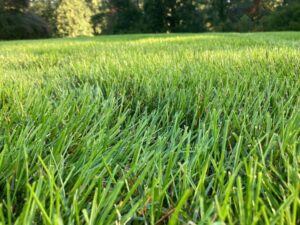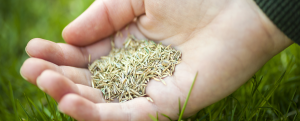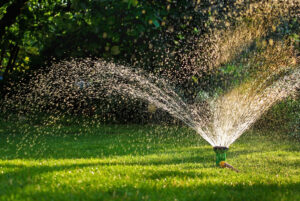More Lawn Care Advice
Core Aeration 101
About Core Aeration 101
Everything You Need to Know About Aeration.
What Is a Core Aeration?
Core aeration is a lawn maintenance practice that involves the removal of small plugs or “cores” of soil from the turf and lawn area. This process is carried out using a specialized machine called an aerator. The core aerator typically has a series of hollow tines or spikes that penetrate the soil and extract cylindrical plugs of soil and thatch from the ground.
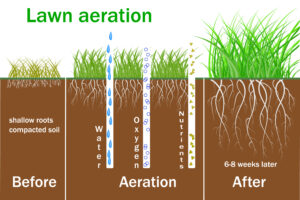
The primary purpose of core aeration is to alleviate soil compaction and improve the overall health of the lawn. Over time, soil compaction can occur due to factors such as foot traffic, heavy machinery, and natural settling. Compacted soil can lead to poor drainage, restricted airflow to the grassroots, and reduced nutrient absorption by the plants. Core aeration helps to address these issues by:
-
Reducing Soil Compaction: The removal of soil cores creates voids in the soil, allowing the remaining soil particles to loosen and expand. This enhances the movement of air, water, and nutrients throughout the soil profile.
-
Improving Water Infiltration: Compacted soil often resists water absorption, leading to runoff and puddling. Core aeration enhances water infiltration, reducing the risk of waterlogged areas and promoting even distribution of moisture.
-
Stimulating Root Growth: Loosening the soil encourages healthier root growth. Roots can penetrate the soil more easily, leading to stronger, deeper root systems that are better able to access nutrients and water.
-
Enhancing Nutrient Uptake: Improved soil structure allows nutrients to move more freely, making them more accessible to the roots of grass plants.
-
Reducing Thatch Buildup: Thatch, a layer of dead grass and other organic matter, can accumulate on the soil’s surface and hinder water and nutrient penetration. Core aeration helps break down thatch by mixing it with soil and promoting decomposition.
Core aeration is typically performed during the growing seasons, either in the spring and/or fall, when the grass is actively growing and able to recover more quickly from the disturbance. The amount of aeration and disruption varies throughout the lawn, and it is not uncommon for us to get aggressive in the areas of the lawn that need the most help to get new seed growing. After core aeration, the extracted soil cores may be left on the lawn to break down naturally or distributed evenly using a drag mat.
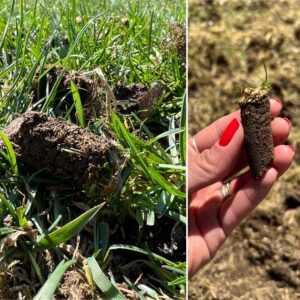
Why Do We Sometimes Use a Drag Mat?
Using a drag mat during aeration serves to help distribute the soil cores and thatch that are pulled to the surface more evenly across the lawn. After core aeration, the extracted soil cores and any loose thatch are left on the lawn. These plugs and debris can create an uneven and unsightly appearance if left concentrated in certain areas. By using a drag mat, also known as a drag mat or a drag harrow, you can achieve several benefits:
-
Even Distribution: The drag mat helps break up the soil cores and thatch and distribute them evenly across the lawn. This prevents the buildup of soil cores in one area, creating a more uniform surface.
-
Promotes Decomposition: Spreading out the soil cores and thatch encourages quicker decomposition. This is important because as these materials break down, they contribute nutrients back to the soil, helping to enrich the turfgrass.
-
Minimizes Disruption: Using a drag mat minimizes the visible disruption caused by the core aeration process. Instead of having scattered plugs and debris, the drag mat helps create a smoother appearance.
-
Enhances Aesthetic Value: A properly used drag mat can improve the overall appearance of the lawn after aeration. It creates a neater look that blends the soil cores and thatch with the surrounding turf.
-
Improves Seed-to-Soil Contact: If overseeding is planned after aeration, using a drag mat can help create better seed-to-soil contact. This increases the likelihood of successful germination and establishment of new grass seed.
-
Encourages Topdressing Penetration: If you plan to apply a topdressing of soil, compost, or other materials after aeration, using a drag mat can help work these materials into the aeration holes and distribute them more evenly.
Overall, using a drag mat in conjunction with core aeration can help maximize the benefits of the aeration process and contribute to a healthier, more attractive lawn.
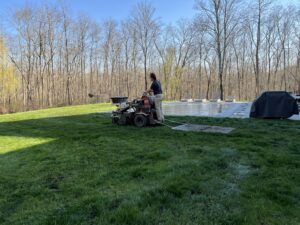
<//div>
Seeding With Aeration
Seeding the lawn after aeration is a common practice known as overseeding. Core aeration and overseeding often go hand in hand, as they complement each other and can greatly improve the health and appearance of your lawn. Here’s how the process works:
-
Core Aeration: Before overseeding, it’s beneficial to perform core aeration to address soil compaction, improve soil structure, and create openings in the soil for new grass seed to establish. Aeration creates a favorable environment for seed germination and root growth.
-
Selecting the Right Seed: Choose a grass seed blend that is appropriate for your climate, soil type, and lawn conditions. It’s often a good idea to select a mixture that includes a combination of grass species for better disease resistance, drought tolerance, and overall resilience.
-
Timing: The timing of overseeding is crucial. The best time to overseed is during the growing season when the existing grass is actively growing, and the weather is conducive to seed germination. In cool-season grass regions, early fall (late August to early September) is typically the optimal time. In warm-season grass regions, late spring to early summer can be a good time for overseeding.
-
Preparing the Area: Before overseeding, it’s a good practice to mow the existing grass slightly shorter than usual to allow sunlight to reach the soil. Raking or using a dethatching machine can help remove any excessive thatch that may inhibit seed-to-soil contact.
-
Seeding: Spread the grass seed evenly over the lawn using a broadcast spreader. It’s recommended to use a slightly higher seed rate for overseeding to ensure good coverage. You can also mix the seed with a carrier material, such as compost, to improve seed distribution.
-
Topdressing: Applying a thin layer of topdressing material (like compost or screened topsoil) over the newly seeded area can help improve seed-to-soil contact and provide additional nutrients.
-
Watering: Proper and consistent watering is crucial for seed germination and establishment. Keep the seeded area consistently moist, but avoid overwatering, as this can lead to disease issues.
-
Mowing: Once the new grass reaches a height of about 3 inches, you can start mowing. Gradually transition to regular mowing practices as the new grass becomes established.
Overseeding after core aeration helps introduce new grass plants into your lawn, filling in thin or bare areas and improving overall turf density. It’s a great way to rejuvenate an existing lawn and promote a lush, healthy, and vibrant turf. Keep in mind that results may vary based on factors such as grass type, weather conditions, and proper maintenance practices.
Watering After an Aeration Service
Watering your lawn properly after core aeration is essential to ensure the success of the aeration process and any subsequent overseeding or lawn repair efforts. Here’s a guide on how to water your lawn after aeration:
-
Initial Watering: After the core aeration process is complete, water the lawn thoroughly. This initial watering helps settle the soil and newly created aeration holes, ensuring good seed-to-soil contact if you’re planning to overseed.
-
Consistent Moisture: Keep the soil consistently moist in the days following aeration and overseeding. This means watering lightly but frequently to prevent the soil from drying out. The goal is to provide an environment that promotes seed germination and establishment.
-
Avoid Overwatering: While it’s important to keep the soil moist, be cautious not to overwater. Overwatering can lead to waterlogged conditions, disease issues, and poor grass growth. Use a light touch and monitor the soil’s moisture level to avoid excessive watering.
-
Time of Day: Water your lawn in the early morning if possible. Morning watering allows the grass to dry out during the day, reducing the risk of fungal diseases that can thrive in moist conditions. Avoid watering in the evening, as extended moisture overnight can encourage disease development.
-
Adjust Sprinklers: Make sure your sprinklers are set to deliver even coverage. Test the coverage pattern and adjust the sprinkler heads as needed to ensure that all areas receive adequate moisture.
-
Watering Depth: Water deeply but infrequently. This encourages the development of deep root systems. Aim for about 6 to 8 inches of moisture penetration into the soil. You can check this by inserting a screwdriver or a soil probe into the ground after watering to see how far the moisture has reached.
-
Evaporation Considerations: If the weather is particularly hot, windy, or dry, you may need to water more frequently to counteract evaporation. Adjust your watering schedule based on the specific weather conditions.
-
Gradual Reduction: As the new grass becomes established, you can gradually reduce the frequency of watering. This encourages the grass roots to grow deeper in search of moisture, leading to a healthier and more drought-resistant lawn.
-
Monitor Soil Conditions: Regularly check the soil moisture level by digging a small hole in the ground and feeling the soil. Adjust your watering schedule based on the moisture level to ensure the soil remains consistently moist but not waterlogged.
Remember that proper watering practices are essential for the health and success of your lawn, whether or not you’ve recently aerated or overseeded. Consistent and mindful watering helps your lawn thrive and ensures the best possible results from your lawn care efforts.
Mowing After an Aeration
Many of our clients choose to skip a week of mowing and if your grass is not too tall you can certainly do that. But if your grass is tall, you can go ahead and mow. Mowing won’t harm the grass seed, but heavy blowing might. If your landscaper likes to strongly blow all the clippings off the grass after mowing, please ask him/her to skip that step until the new seed has become new lawn. Also ask that they do not bag the clippings. They should also avoid any areas of the lawn that are bare for 2-3 weeks.
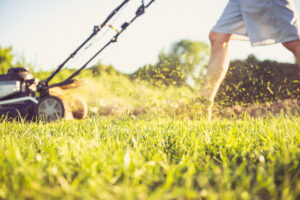
REMEMBER!
Irregular growth is normal. Not only is every lawn unique, but every small area of every yard is unique too! It’s very normal for patches of your lawn to dry out more quickly than others (more sun, sandier soil, etc.). With that in mind, you’ll likely see grass seed growing in some spots much more quickly than in others. If anything does not fill in, we will re-seed those spots (at no extra charge) during our next visit.
